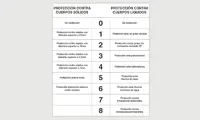7 things you need to know before using 12V LED light strips
Flexible LED flexible light strips are widely used in various industrial, commercial and residential lighting projects around the world. LED strip lighting is popular among many architects and lighting designers due to its energy saving, rich color variety and increased brightness. The biggest appeal of LED flexible light strips is their ease of installation. Their flexibility, low profile and versatile accessories make them the most popular LED light strips among the home DIY genre. With these LED light strips, homeowners can design and install them themselves, just like a professional designer, in just an hour or two.
There are many options for LED light strips, and there is no simple "one size fits all" standard. This LED strip buying guide will guide novices and experts alike in finding the best LED strips for projects and how to use them while overcoming common installation roadblocks.
This guide will educate novices and experts alike on finding the best LED light strips for the job and how to use them while overcoming common installation roadblocks.
LED Light Strips: What Makes Them So Special?
LED flexible light strips, also known as LED light strips or LED flexible light strips, are widely used because of their slim size and flexibility. High-efficiency LED light strips are mounted on 10mm wide circuit boards with lengths from 1 meter to 5 meters. Flexible LED light strips come with many features, making them easy to use in a variety of situations:

Cutting Size – Cutting LED light strips is very simple by following the cutting lines on the LED light strips. There is a black line at each cut point and copper pads on each side. Copper pads make each strip piece workable even after cutting. This allows you to connect LED light strips together, or connect light strips to different areas of your home.

Flexible LED Light Strips with Double-Sided Adhesive Backing – LED light strips feature a 3M adhesive backing for easy installation options. Thin, flexible LED light strips feature a peel-off backing that exposes 3M adhesive for simple peel-and-stick installation.

Waterproof or not – LED flexible light strips aren’t just limited to indoor projects. Waterproof LED light strips are rated IP65 or IP67/IP68 and are made of silicone material to protect the strip components from dust and moisture. Waterproof LED light strips are a bit more expensive, but a must-have for any project outdoors or near water.
12V LED Light Strips – LED light strips require 12V DC power input to operate. This will require an AC/DC transformer for home use, making it safer for home applications. Batteries also output DC power, so it's easy to make battery-powered LED lights with these LED flexible light strips.
7 Things You Need to Know Before Installing LED Light Strips
LED flexible light strips are suitable for a variety of projects, but sometimes it's hard to know where to start. If you don't know where to start, follow this 7-step guide. This guide shows various LED light strip options as well as plans to make your home LED strip lighting a complete success!
LED strip density = brightness
The density of the LED strip means how many LED beads there are in the set area. For LED flexible strips, density is measured in "LEDs per meter." Standard density strips have 30 LEDs/M, while high density strips have 60 LEDs/M. Higher density strips equate to higher quality, brighter light. The table below shows the differences between standard and high density strips. Note the lumen output and the difference between each cut length and the maximum run length.
| density | LED quantity | lumen | Watts (per volume) | Minimum cutting size | The maximum length |
| regular density | 30/meter | 540/meter | 27 watts | 10cm | 10 m |
| high density | 60/meter | 1080/meter | 40 watts | 5cm | 5m |
Lumens are a measure of brightness perceived by the human eye. For incandescent lighting, most of us use wattage to measure the brightness of a light. For LEDs, lumens are the new standard for describing light output. Lumen output is one of the most important parts of choosing an LED light strip, as it will determine the type of light you will receive.
Make sure to pay attention to how lumens are tracked when comparing LED strip brightness. In the table above, the strips are labeled as lumens per meter. To find the total lumen output, simply find how many meters you will install it.
Lumen output is one of the most important parts of choosing an LED light strip, as it will determine the type of light you will receive.
Different projects require a certain amount of brightness to serve their purpose. My advice is to always choose the brighter option and add a dimmer. Here is a helpful guide to lumen requirements:
Atmospheric or mood lighting – 100-300 lumens/foot. (Each foot is approximately equal to 3 meters)
Cabinet lighting – 175-360 lumens/foot.
Workroom lighting or light source located further away - 300-450 lumens/foot.
Bedroom, troffer lighting – 180-500 lumens/foot.
Color: RGB multi-color, UV, single color, CCT color temperature
LED strip color depends on personal preference. RGB LED light strips are a great choice for those who like a variety of colors and color effects. RGB strip lights are color-changing light strips that are perfect for accent lighting in your home. They use red, green and blue diodes so that they can be mixed to produce many different colors. If you are using an RGB strip, make sure to use the 3-channel controller from the dimming section of this guide.
Ultraviolet (UV) version of the strips available. This is a great option for UV applications or making your own black light!
LED strips are also available in single colors: red, green, blue, yellow and white (3000-6500K CCT).
CCT stands for Correlated Color Temperature, which is the color temperature of light in degrees Kelvin (K). The color temperature of the LED strip directly affects the appearance of the light. Please see the photo below for reference. Warm white is what we call 3000K, which gives it an orange or yellowish appearance. As we increase the degree of Kelvin the color changes from yellow to white to natural white and then to bluish white which is called cool white.

So which color do I choose? Use warm white, neutral white and cool white stripes to look at the room below. Note how the color temperature of the LED strip affects the overall appearance of the room. It all comes down to personal preference and overall style, and that reflects through the room lighting

The warm white color creates a warm and comfortable atmosphere. It is usually used in rooms for gathering or relaxing (living room, bedroom, dining room, etc.).

Neutral or natural white creates a natural daylight effect. This is the best-selling LED light strip because it mimics natural light and can be used comfortably anywhere in the home. This is our most popular cabinet LED lighting strip.
Cool White complements modern and contemporary styles, creating a bright and fresh glow. Cool white is great for the workspace because it is a brighter, more concentrated light. Use the brightest, coolest colors in bathrooms, kitchens and work spaces.
LED light strip length
It’s a good idea to outline the entire project and see how many meters of light strip you will be using. This can give you an idea of what materials you are purchasing and how much it will cost. The LED light strip is 1 meter long. Increase to one roll (5 meters). It is important to determine if you want to purchase the reel length and cut it to size, or if it would be beneficial to have a smaller length cut for you.
At this stage, draw your project. Plan where you will need the strip lights, how they will be connected, and whether they will all return to the same power source or have separate power supplies. This step will help a lot as you work through the next few steps.
LED strip power and supply
What type of power supply does an LED light strip require? LED strip lights always require 12V or 24V DC input.
This is the easy part, the next step is to find the wattage. As shown in the image below, this shouldn't be too complicated if you've already selected your strip density and overall length.
Detailed wattage table for 12V LED strips
| Length (feet) | Length (meters) | 30 LEDs/M. Watts |
60 LEDs/M. Watts |
| 1 | 0.3048 | 2.4 | 4.8 |
| 2 | 0.6096 | 4.8 | 9.6 |
| 3 | 0.9144 | 7.2 | 14.4 |
| 6 | 1.8288 | 12.15 | 20.8 |
| 9 | 2.7432 | 17.1 | 27.2 |
| 12 | 3.6576 | 22.05 | 33.6 |
| 16.4 | 5 | 27 | 40 |
If you are using multiple power supplies, note the length of each power supply to find the size you need.
LED power options:
Plug-in Adapter – Plugs directly into the wall to power LED strips.
Cable Powered – Wire directly between the line voltage wire and the LED strip.
Dimmable Power – Want to use CL Light’s, 4G, Bluetooth and WIFI LED strip dimmer? The editor strongly recommends!
Batteries – Find a 12V battery pack or use an 8-cell battery holder.
Wiring and Connecting LED Strips
This is where the previous sketch will come in handy, start thinking about where you will install all the LED strips. Do you plan to run all strips long term? If the total length you require exceeds the maximum running length of the strips (10 meters for SD and 5 meters for HD), then you will need to connect the parallel wires from the power supply to a separate strip, or use a longer constant length. Streaming light strip.
As our sketch shows, sometimes you'll want to plug power cords from different directions into a common power source. In this case you will already be running parallel lines.
Wiring LED strips can be difficult when you're dealing with multiple LED strips, but we have a Power and Wiring Guide that you can follow to draw up your LED strip setup.
Wiring accessories: LED strip connectors and splitters
Any LED light strip project requires connecting LED strips. We've got some helpful accessories and guides to complete any LED strip connection.
Wire soldering and self-installation connections? Be sure to follow our welding guidelines and find our recommended strip welding wire here.
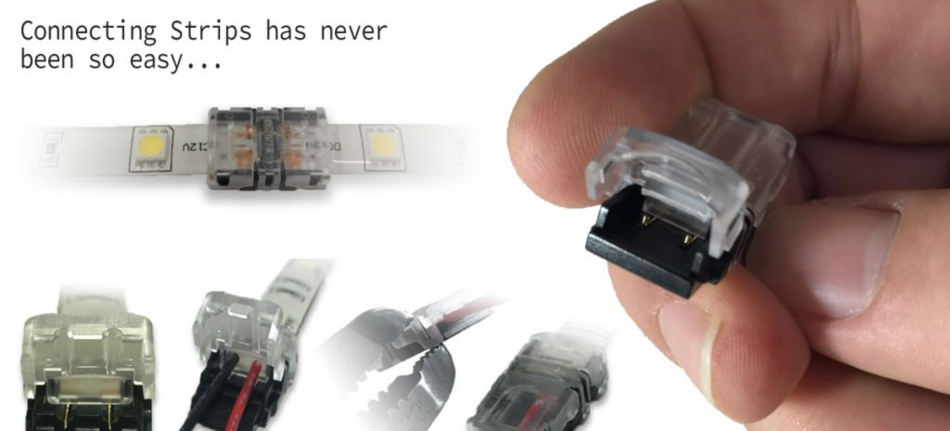
How to connect LED strips without soldering? Our Hippo Buckle Connectors are ideal for connecting LED strips end to end, running gaps between LED strips or running around corners. Our guide to the full range of LED light strip connectors shows how to use these connectors to provide easy connections for any LED light strip project.
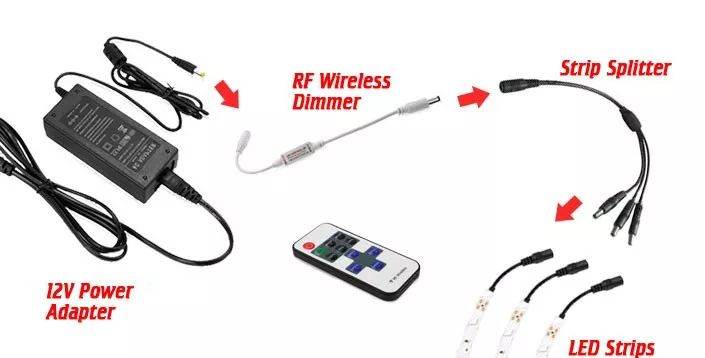
How to connect multiple LED strips to one power supply? The LED light strip splitter makes it easy to plug multiple strips into one power source! Strip splitters are available with 2, 3 or 4 output channels.
Dimmable LED light strip
LED light strips are typically dimmed using an in-line pulse width modulation (PWM) dimmer. These dimmers are made on the 12V side of the system and wired between the strips as shown.
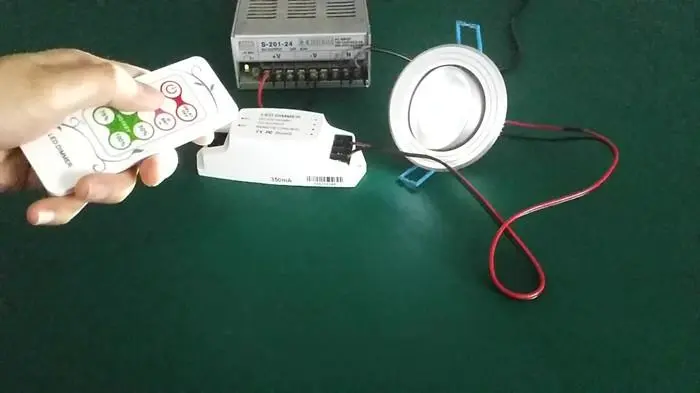
PWM dimmers are popular because they can be used with any transformer or battery power source, they do not need to be listed as dimmable. PWM dimming provides smooth control from darkest to brightest settings. PWM LED strip controller is reasonably priced and easy to install, making it the first choice for dimming LED strips.
Some homeowners already have central dimming systems for their areas. In these cases, homeowners want to use existing AC dimmers to control the lights. If you want to use an AC dimmer like this, then you will need a dimmable power supply, as described here.
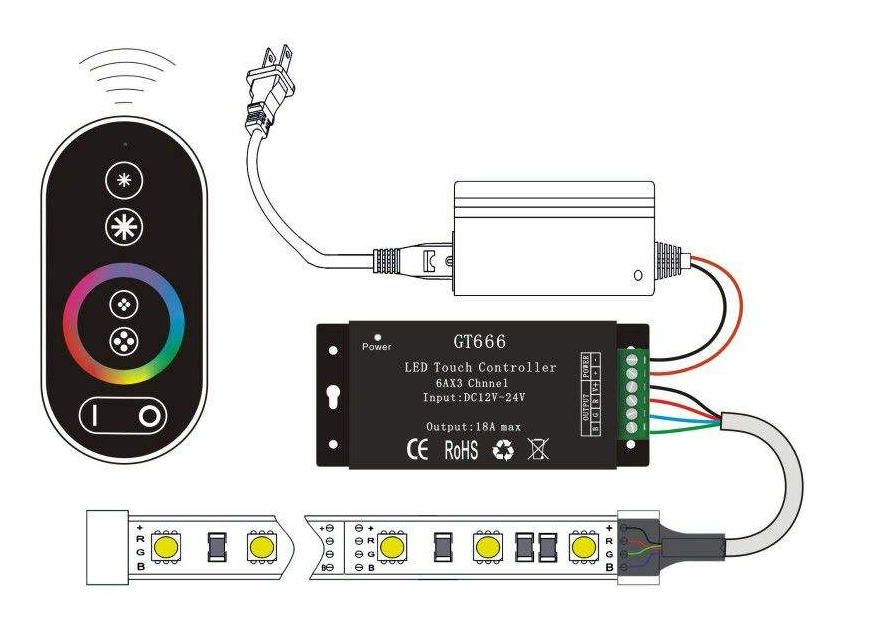
RGB LED Controller – If you have a color-changing RGB LED strip, then you will need a 3-channel RGB controller. These controllers control the red, green and blue channels to mix the colors and create the color changing effect of the LED strips. Your RGB LED strip won't work properly without this unit, so be sure to buy it if you're using a multi-color LED strip.
Install LED light strips
Adhesive backing on LED strips is very helpful when installing, but sometimes more is needed. Like most adhesives, it doesn't bond well to certain surfaces and may need to be strengthened over time. In these cases, use one of the following options:
Extra Tape – 3M tape placed on the surface before tape to double the bond.

Installing aluminum troughs is another great option for those who want a professional finish to their light bar installation. These aluminum troughs hold your light strips and have everything you need to install them. The LED strips are glued to the bottom of the aluminum trough. Cover it with an anti-UV cover/lens to diffuse the light


